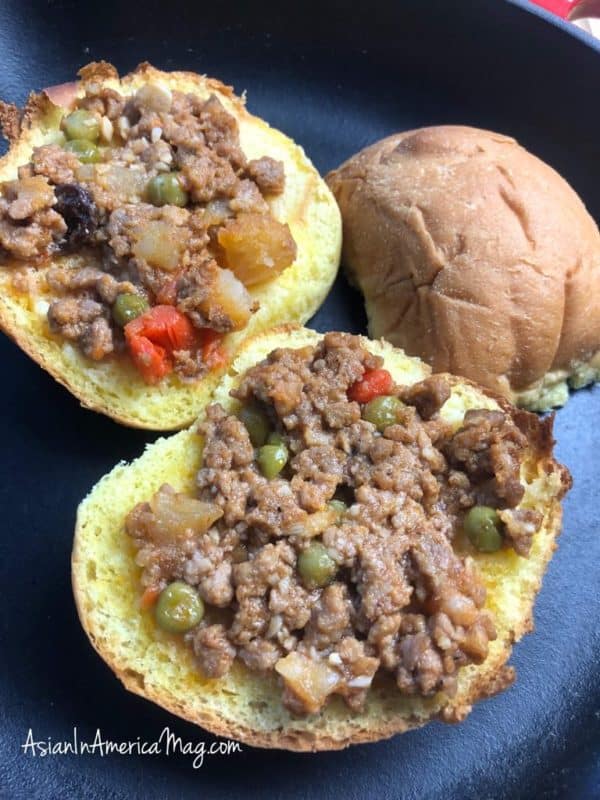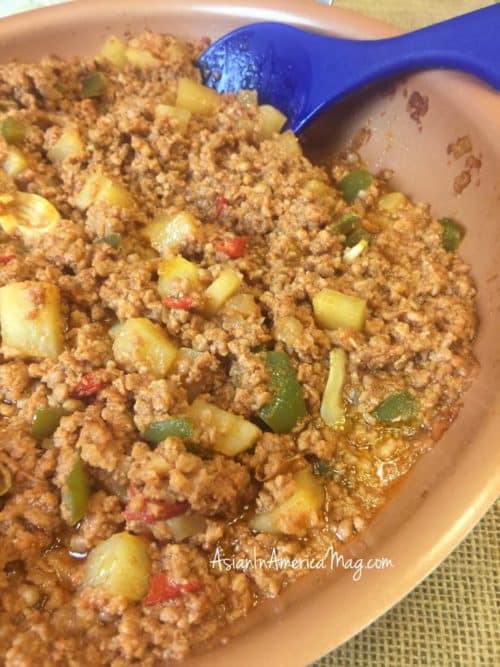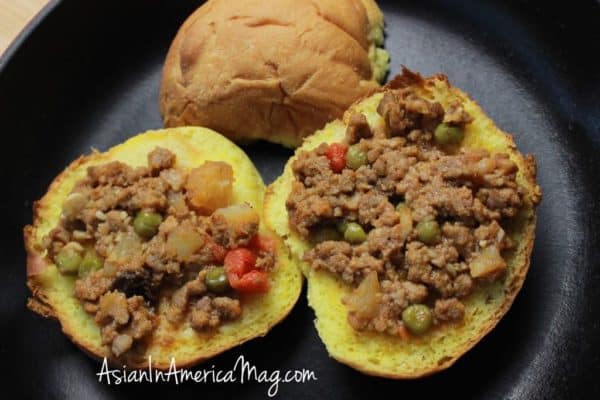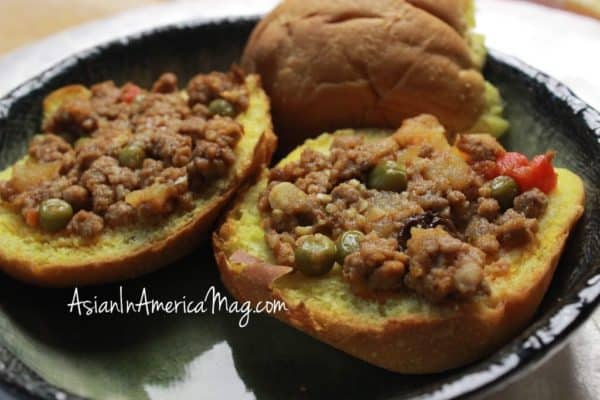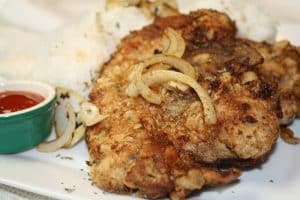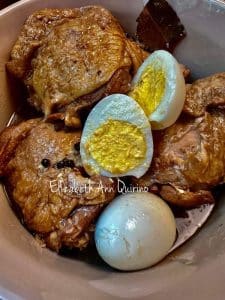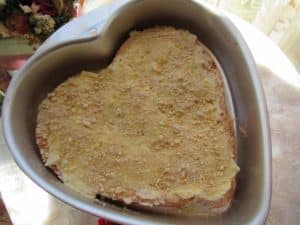Filipino Putong Babi: Open-Faced Pork Bun
As an Amazon Associate and member of other affiliate programs, I earn from qualifying purchases.
‘Putong babi’ is Kapampangan which translates to ‘bread with pork’, but you can use either pork or beef. This is a Filipino sweet-flavored meaty snack on bread. You can cook picadillo, a classic entrée of ground pork-beef mixture with potatoes, peas, carrots, and use the leftovers to make ‘putong babi’.
“Paradadas” is its traditional name in Pampanga and was how my mother-in -law called these open-faced buns with ground meat. The Filipino Putong Babi (say ‘pooh-tong bah-bee’), is a favorite snack in Pampanga, a province north of Manila, the country’s capital. It was simply pan de sal, the Filipino bun, sliced in half, with a ground meat- raisins mixture spread on it, coated with beaten eggs and bread crumbs on top. This whole assembly was then pan-seared stove top, and pressed down with a turner to cook Panini-style. These days, in my American kitchen, I improvised and baked it in the toaster oven, on busy school days.
Whenever we visited my in-laws in Tarlac, Mama had putong babi ready for merienda (snack). After a long drive from Manila, it was sheer comfort to come home to these treats. Straight from the skillet, the paradadas were warm, and crusty. The savory meat-potatoes-peas topping with cheese was superb as we sunk our teeth into the layers. The aromas of toasted bread with the robust pork topping floated around the table. Mama served these paired with frozen Pampanga fruit salad in heavy cream decoratively laden in parfait glasses. Was it any wonder we didn’t want to leave?
When we moved to America and my sons were growing up, I took the cue from Mama. I made sure my sons came home to putong babi for their after-school snacks paired with a glass of chilled beverages. It was comfort food in a bun.
Filipino Putong Babi: Open-Faced Pork Bun
Equipment
- 1 Large non-stick skillet, approximately 12-inches in diameter
- 1 Turner
- Mixing bowls
- chopping board
Ingredients
- 8 to 10 whole pieces large Pan de Sal (Filipino bread bun); or use large dinner rolls; or hoagie bread
- 2 Tablespoons vegetable oil
- 2 cloves garlic peeled, minced
- 1 whole medium-sized onion chopped
- 1/2 pound ground pork or use ground beef; or combination of both
- 1 Tablespoon calamansi juice (or use lemon juice)
- 2 Tablespoons toyo (soy sauce)
- 2 large potatoes or sweet potatoes (camote); peeled, cubed into 1/4-inch pieces
- 1/2 cup chopped carrots
- 1/2 cup green peas frozen or canned; drained
- 1/2 cup raisins
- 1/2 teaspoon salt
- 1/2 teaspoon ground black pepper
For topping:
- 2 whole pieces large eggs beaten
- 1 cup bread crumbs
- 1/2 cup grated cheddar cheese
Instructions
To prepare Pan de Sal:
- Slice the bread buns in half. Cover and set aside in a bread box to prevent them from drying up or hardening.
To cook the ground meat:
- In a large skillet, over medium-high heat, add the vegetable oil. When oil is hot enough, saute the garlic and onions. After 1 to 2 minutes, when onions are fragrant, add the ground pork. Pour the calamansi (or lemon juice) and soy sauce. Combine the ingredients.
- Add the potatoes or sweet potatoes, and carrots to the skillet. Mix the ingredients well. Cover and cook for 8 to 10 minutes till meat and potatoes are done.
- To the skillet, mix in the green peas and raisins. Season with salt and black pepper. Remove from the stove-top and let the meat mixture cool on the counter for at least 15 minutes.
To assemble the Putong Babi:
- Take each Pan de Sal half and spread around 2 tablespoons of the meat-potatoes mixture all over the open bun. Pour 1 tablespoon of beaten egg on the meat topping. Distribute evenly sprinkles of bread crumbs and grated cheese on the meat topping of each bun. Do this for all the bread buns.Spritz cooking spray all over a large non-stick skillet. Over medium heat, place each Pan de Sal open bun topped with the meat mixture into the skillet. Lay the buns meat side down. Using a turner, press down on each bun as it pan sears and the skillet sizzles. Do this for 2 to 3 minutes while the bun flattens. Turn the slice over in the skillet. Flatten the top (with the filling) with the turner. Let the bottom brown for 1 to 2 minutes. Transfer to a serving platter and serve warm.
Cook's comments:
- You can cook the picadillo in advance a few days ahead and serve it as an entree. Use the leftovers to make these Putong Babi. The recipe for picadillo is in a past blog post. Click here.In Pampanga, the traditional Putong Babi ground pork mixture used cubed camote (sweet potatoes) instead of the regular potatoes I used here. Feel free to use whichever is convenient.If preferred, toast the entire Putong Babi in a toaster oven for 3 to 4 minutes on High, instead of pan-searing in a skillet.The Filipino Pan de Sal is sold in Asian markets or Filipino groceries. Some can be purchased through online groceries. If not available, use large dinner rolls or hoagie bread. If you want to make your own homemade Pan de Sal, you can bake it ahead and freeze it. Here is my recipe for Pan de Sal - click here.
Copyright notice:
- Hello, Friends! Please DO NOT LIFT OR PLAGIARIZE my original recipe, stories, photos or videos. All the images and content on this blog are COPYRIGHT PROTECTED and owned by my media company Besa-Quirino LLC. This means BY LAW you are NOT allowed to copy, scrape, lift, frame, plagiarize or use my photos, essays, stories and recipe content on your websites, books, films, television shows, videos, without my permission. If you wish to republish this recipe or content on media outlets mentioned above, please ASK MY PERMISSION, or re-write it in your own words and link back to my blog AsianInAmericaMag.com to give proper attribution. It is the legal thing to do. Thank you. Email me at [email protected]
Nutrition
Notes on Nutrition: The nutrition information provided is an estimate and will vary based on cooking methods and specific brands of ingredients used.
Did you like this recipe? I have more classic recipes inspired by my late mother’s cooking in my popular cookbook: My Mother’s Philippine Recipes. If you’re learning how to cook Filipino food or a fan of Philippine cuisine, buy my cookbooks and books on Amazon.com sold worldwide in paperback and Kindle format.
Hello, Friends! Please DO NOT LIFT OR PLAGIARIZE my original recipe, stories, photos or videos. All the images and content on this blog are COPYRIGHT PROTECTED and owned by my media company Besa-Quirino LLC. This means BY LAW you are NOT allowed to copy, scrape, lift, frame, plagiarize or use my photos, essays, stories and recipe content on your websites, books, films, television shows, videos, without my permission. If you wish to republish this recipe or content on media outlets mentioned above, please ASK MY PERMISSION, or re-write it in your own words and link back to my blog AsianInAmericaMag.com to give proper attribution. It is the legal thing to do. Thank you. Email me at [email protected]

